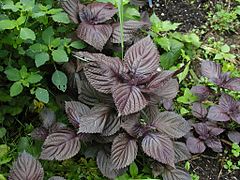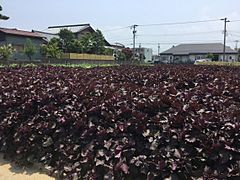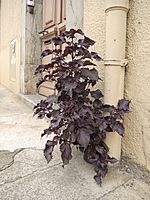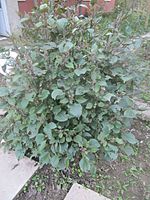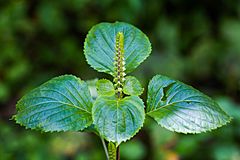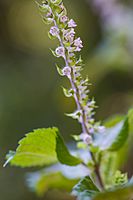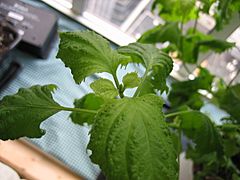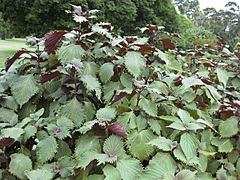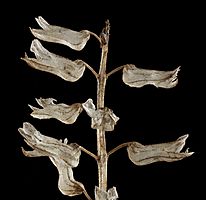Shiso facts for kids
Quick facts for kids Perilla frutescens var. crispa |
|
|---|---|
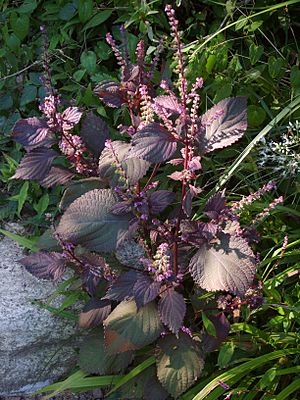 |
|
| Red shiso | |
| Scientific classification |
|
| Kingdom: | Plantae |
| Clade: | Tracheophytes |
| Clade: | Angiosperms |
| Clade: | Eudicots |
| Clade: | Asterids |
| Order: | Lamiales |
| Family: | Lamiaceae |
| Genus: | Perilla |
| Species: | |
| Varietas: |
P. f. var. crispa
|
| Trinomial name | |
| Perilla frutescens var. crispa (Thunb.) H.Deane
|
|
| Synonyms | |
|
|
Shiso (scientific name: Perilla frutescens var. crispa) is a special type of herb from the mint family. It's known by its Japanese name, shiso. This plant originally grew in the mountains of China and India. Now, you can find it all over the world.
Shiso plants come in different forms. Their leaves can be red, green, or even two colors. Some leaves are also ruffled. Shiso is a perennial plant, meaning it can live for many years. However, in colder places, people often grow it as an annual plant, which means it lives for only one year. Different parts of the shiso plant are used in cooking, especially in East Asian and Southeast Asian countries.
Contents
What is Shiso Called?
This herb has many names around the world.
Names in Asia
In China, it's called zǐsū, which means "purple perilla." This is where the Japanese name shiso comes from. In Vietnam, it's known as tía tô, and in Korea, it's called soyeop.
English Names for Shiso
In English, shiso is sometimes called the "beefsteak plant." This is because the purple leaves look like the color of meat. Other common names include "perilla mint," "Chinese basil," and "wild basil." In some areas, like the Ozarks, it's called "rattlesnake weed." This is because the dry stalks make a sound like a rattlesnake when you walk past them. The name shiso became popular in English in the 1990s because of the growing popularity of sushi.
Avoiding Confusion with Other Plants
Sometimes, people just call the plant "Perilla." But this can be confusing! There's another type of perilla called Perilla frutescens var. frutescens. To avoid mixing them up, this other plant is called egoma in Japan and deulkkae in Korea.
Where Did Shiso Come From?
Scientists believe shiso first grew in the mountainous areas of India and China. Some also think it might have started in Southeast Asia.
A Brief History of Shiso
Shiso was grown in ancient China a very long time ago. One of the first records of it is from a book written around 500 AD. This book described some of its uses. The plant then came to Japan between the 700s and 800s.
Red shiso arrived in England for gardeners around 1855. Later, in the 1860s, it was brought to the United States. Today, shiso can sometimes grow so easily that it's considered a weed or an invasive plant in some places.
What Does Shiso Look Like?
Shiso plants usually grow to be about 40 to 100 centimeters (about 1.3 to 3.3 feet) tall. They have wide, oval-shaped leaves with pointy ends. The edges of the leaves are serrated, meaning they have small teeth like a saw. The leaves grow in pairs opposite each other on long leafstalks.
Shiso seeds are very small, about 1 millimeter in size. They are also harder than the seeds of other perilla plants. Shiso plants don't like frost. In warm areas (USDA zones 11 and above), they can grow year after year.
Different Types of Shiso
There are several types of shiso, mainly recognized by the color and shape of their leaves. The stems and flower buds can also show these colors. The red color in shiso comes from a natural pigment called shisonin. The first red shiso studied by Western scientists had wavy or curly leaves. This is why it was given the Latin name crispa, which means "wavy" or "curly."
-
Red shiso field in Fukui City, Japan
-
Red shiso in Saint-Girons, France
-
Bicolor shiso in the Royal Botanic Garden, Sydney, Australia
How is Shiso Used in Cooking?
People eat cultivated shiso in many countries in East and Southeast Asia. Wild shiso plants are usually not good for eating. They don't have the nice shiso smell and can contain a substance called perilla ketone, which can be harmful.
Shiso in East Asian Cooking
Japan
| Red shiso (f. purpurea) | Shiso (紫蘇) |
| Akajiso (赤紫蘇) | |
| Ruffled red shiso (f. crispa) | Chirimen-jiso (縮緬紫蘇) |
| Green shiso (f. viridis) | Aojiso (青紫蘇) |
| Ōba (大葉) | |
| Ruffled green shiso (f. viridi-crispa) | Chirimen-aojiso (縮緬青紫蘇) |
| Bicolor shiso (f. discolor) | Katamen-jiso (片面紫蘇) |
| Variegated shiso (f. rosea) | Madara-jiso (斑紫蘇) |
Shiso is used a lot in Japanese cuisine. Red, green, and bicolor types are used for different dishes.
Red Shiso Red shiso is called akajiso. It's used to make umeboshi, which are pickled plums. The red shiso leaves give the plums their bright red color. When steeped in umezu (the salty liquid from pickling plums), the leaves turn a vibrant red. You can also mix red shiso with umezu to make some types of sushi. In the summer, people use it to make a sweet, red juice. In Kyoto, red shiso and its seeds are used to make shibazuke, a type of pickled eggplant.
Dried red shiso leaves are ground into flakes and mixed with salt to make a seasoning called yukari. This seasoning is often sprinkled over rice or mixed into onigiri (rice balls).
Green Shiso Green shiso is called aojiso or ōba ("big leaf"). It's used to decorate noodle dishes like hiyamugi or sōmen. It also garnishes meat dishes like sashimi, tataki, and namerō, and tofu dishes like hiyayakko. Whole leaves can be used to hold wasabi or other garnishes. People also fry green shiso leaves in a light batter to make tempura. Chopped leaves add flavor to many fillings or batters. Sometimes, pasta in Japan is topped with fresh or dried shiso leaves, often mixed with raw tarako (pollock roe). Green shiso was even used as a substitute for basil on pizza. In 2009, Pepsi Japan released a green-colored Pepsi Shiso drink!
Other Parts of the Plant Shiso seed pods, called shiso no mi, are salted and used as a spice. They can be mixed with thin slices of daikon (radish) to make a simple salad. Oil from the seeds was once used for deep-frying.
Young shiso sprouts and buds are called mejiso. They are used as garnishes, especially for sashimi. Red sprouts are called murame, and green sprouts are aome.
Shiso flowers, called hojiso, are also used as a garnish for sashimi. You can scrape them off the stalk with chopsticks and add them to your soy sauce dip for extra flavor. The flowers can also be pickled.
-
Various types of sushi with green shiso leaves
-
Ikura-don with green shiso garnish
-
Shimesaba (cured mackerel) and whitebait sashimi with green shiso leaves
-
Green shiso leaf used to hold sashimi
-
Umeboshi pickled with red shiso
Korea
In Korea, shiso is called soyeop or chajogi. It's not as popular as another related plant called P. frutescens (deulkkae). Soyeop often grows wild, and its leaves are sometimes used as a ssam vegetable (a leaf used to wrap food). Red leaves are sometimes pickled in soy sauce or soybean paste or deep-fried with a thin coating of rice flour.
-
Yukhoe (raw steak) with green shiso leaf
Shiso in Southeast Asian Cooking
Laos
In Laos, red shiso leaves are called pak maengda. They are used to add a nice smell to khao poon, a rice vermicelli dish similar to Vietnamese bún.
Vietnam
In Vietnam, shiso is called tía tô. Compared to Japanese shiso, Vietnamese tía tô has slightly smaller leaves but a much stronger, more fragrant flavor. Vietnamese tía tô leaves are often two-colored, with red on the back side.
Tía tô leaves are used in Vietnamese cuisine for salads, soups, or stir-fried dishes. Their strong flavors are great for cooking seafood like shrimp and fish. They are also eaten as a garnish with bún (rice vermicelli). The leaves can also be pickled.
Growing Shiso
In places with mild climates, shiso plants can reseed themselves. However, the seeds don't last long, and fewer new plants will grow from old seeds after about a year.
Shiso Production in Japan
The graph above shows how much shiso was produced in Japan each year. This information comes from the Ministry of Agriculture, Forestry and Fisheries.
The biggest area for growing shiso for food is Aichi Prefecture. In 2008, Aichi produced 3,852 tons of shiso, which was about 37% of all shiso grown in Japan. Most of this shiso is grown in greenhouses. The city of Toyohashi in Aichi Prefecture grows the most shiso in Japan.
History of Shiso Farming in Japan
Green shiso wasn't grown on a large scale until the 1960s. Before 1976, not much was produced.
One story says that in 1961, a food group from Shizuoka started sending green shiso to the Osaka market. It became so popular that the name ōba ("big leaf") became the common name for bunches of green shiso leaves.
Another story says that green shiso farming started in Toyohashi around 1955. Farmers there began selling the leaves as ōba around 1962. By 1970, they were able to grow shiso all year round.
In the 1970s, new ways to store and transport food in refrigerators became available. This meant fresh foods like sashimi could be sent to many places. Because of this, garnishes like green shiso also became very popular.
The word ōba was originally a special trade name. It wasn't officially listed in a popular Japanese dictionary as "green shiso" until 1997.
Images for kids


